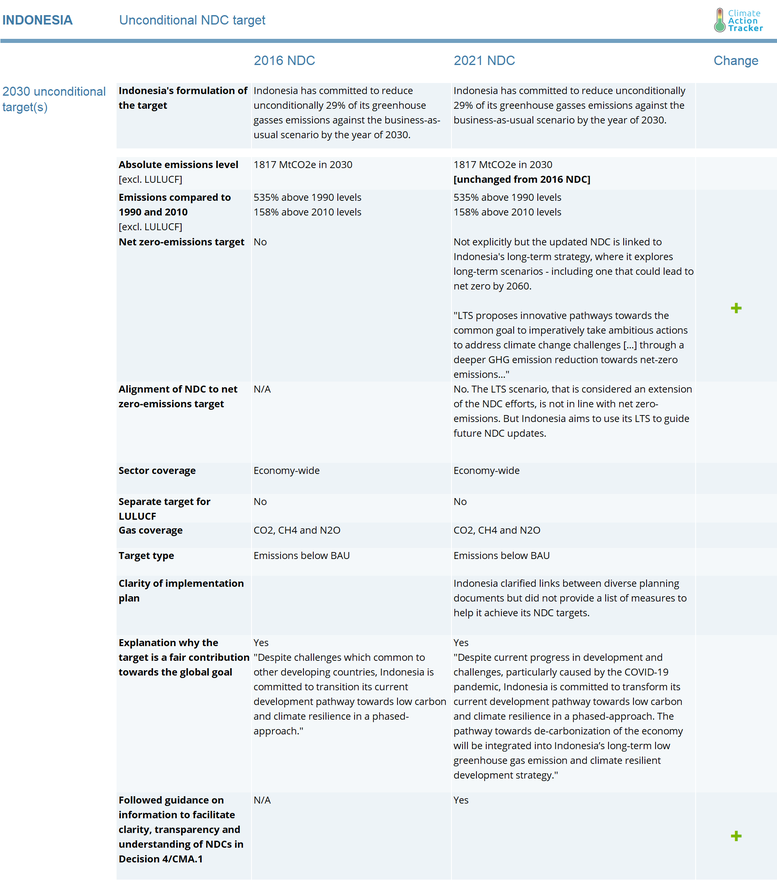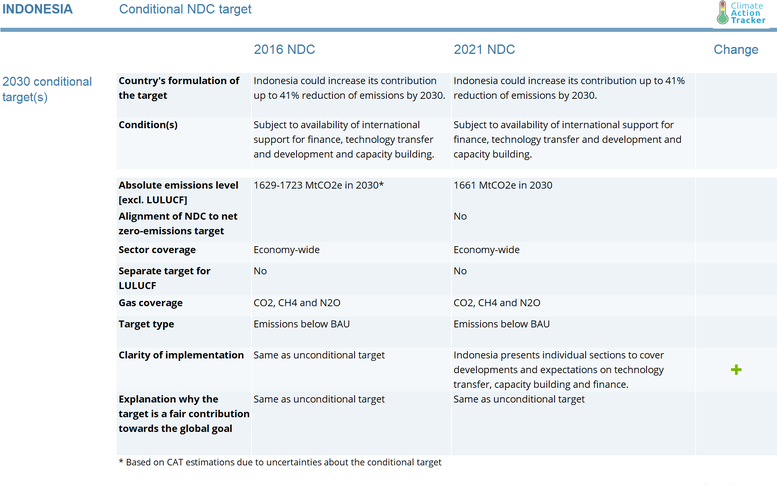CAT Climate Target Update Tracker
Indonesia
Summary
Indonesia improves long-term planning towards net zero, but NDC remains unchanged
Indonesia submitted its updated NDC in July 2021, where it did not strengthen the country’s 2030 target. Targets remain unchanged and would lead to emissions significantly above current policies. Even though the targets remain effectively unchanged, the updated NDC does present several improvements in terms of transparency and links with other planning documents. Indonesia does not yet commit to a net zero target, but explores scenarios that could lead to net zero by 2060 or sooner and aims to use these scenarios to inform future NDC revisions.
CAT analysis of NDC
![]()
On 22 July 2021, Indonesia submitted its updated NDC, confirming its existing 2030 targets. Indonesia once again commits to an unconditional 29% reduction in emissions below a business-as-usual (BAU) scenario, and a conditional 41% reduction in emissions below the same BAU. The updated NDC links to the long-term strategy (LTS), submitted on the same day. Indonesia opens the door to setting a net-zero target, and presents a pathway compatible with doing so by 2060 in its LTS. The country also commits to considering the LTS in the formulation of broader development planning documents and subsequent NDCs.
Indonesia confirms its existing targets in the updated NDC submission. Similar to the previous NDC submission, there were still some inconsistencies between the percentage reduction conditional target and the table presented in the NDC. In August 2021, Indonesia submitted an erratum that corrected these issues.
Indonesia states that the updated NDC is a progression in comparison to the previous one, due to a slight update in the BAU scenario, from 2,881 to 2,869 MtCO2e/year in 2030. However, the BAU presented in the previous NDC was already 2,869 MtCO2e/year in 2030. An absolute emissions target would constitute an improvement on Indonesia’s NDC. Maintaining the same BAU scenario and percentage reduction targets indicate no real progress on the nation’s mitigation objectives.
The NDC relative reductions below BAU may sound ambitious, but a closer look reveals a different picture. The Indonesian NDC projects emissions in the forestry sector to be reduced in comparison to 2010 historical levels, but emissions in the other sectors are still allowed to almost triple by 2030. Therefore, these other sectors will see substantially lower relative reductions below BAU. The absolute emissions levels (excluding forestry) resulting from the unconditional NDC remains at 1,817 MtCO2e/year in 2030, the conditional NDC target leads to 1,661 MtCO2e/year. This means respective relative reductions of 16% and 23% below BAU, excluding forestry.
Indonesia is well on its way to meeting both its unconditional and conditional targets, excluding forestry. The BAU used in the NDC projects an increase which is substantially above current policies projections. In fact, Indonesia will likely achieve its targets (excluding forestry) without additional efforts.
Recently, the state-owned electricity utility (PLN) announced that it will stop building coal fired power plants after 2023. This still implies several coal-fired power plants will be built. However, this move may reduce emissions under current policies even further. A recent analysis by the CAT shows that an early phase out of old coal-fired power plants in combination with a moratorium on new coal burning plants could reduce emissions by 7-11% and help avoiding over 45,000 premature deaths caused by air pollution by 2030.
Even though the targets remain effectively unchanged, the updated NDC presents several improvements. It provides more detail on adaptation as elaborated in the programmes, strategies and actions to achieve economic, social and livelihood, and ecosystem and landscape resilience. It also provides more clarity on mitigation by adopting the Katowice Package, as well as updated policies which potentially contribute to additional achievement of NDC target. It also presents milestones along with national development plans for the period of 2020-2024, and indicative pathways towards long-term vision (Visi Indonesia 2045 and the Long-Term Strategy on Low Carbon and Climate Resilient Development 2050.)
The LTS presents three long-term emissions scenarios for Indonesia: current policy (CPOS), transition (TRNS) and low carbon (LCCP). CPOS is a scenario in line with the NDC unconditional target and the transition scenario bridges the CPOS to LCCP. The document states that the only scenario compatible with the collective goals of the Paris Agreement is the LCCP scenario (page 34). This scenario is expected to provide “opportunity for more rapid progress towards net-zero emission in 2060 or sooner.”
Indonesia does not yet commit to a net zero target, but explores scenarios that could lead to net zero and aims to use these scenarios to inform future NDC revisions. A more detailed analysis of long-term targets is forthcoming.
Having in place the necessary climate governance frameworks is a critical element to being able to deliver the transition to a zero emissions society. For more detail, see the CAT’s Climate Governance Series. The CAT is preparing an update of the 2019 Governance series, which will include both the NDC and LTS submissions.
Links
Stay informed
Subscribe to our newsletter

